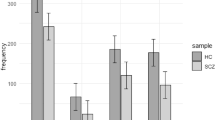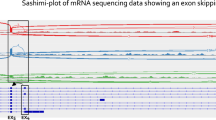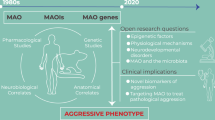Abstract
Genetic studies of delinquent and criminal behavior are rare in spite of the wide recognition that individuals may differ in their propensity for delinquency and criminality. Using 2524 participants in Add Health in the United States, the present study demonstrates a link between the rare 2 repeat of the 30-bp VNTR in the MAOA gene and much higher levels of self-reported serious and violent delinquency. The evidence is based on a statistical association analysis and a functional analysis of MAOA promoter activity using two human brain-derived cell lines: neuroblastoma SH-SY5Y and human glioblastoma 1242-MG. The association analysis shows that men with a 2R report a level of serious delinquency and violent delinquency in adolescence and young adulthood that were about twice (CI: (0.21, 3.24), P=0.025; and CI: (0.37, 2.5), P=0.008 for serious and violent delinquency, respectively) as high as those for participants with the other variants. The results for women are similar, but weaker. In the functional analysis, the 2 repeat exhibits much lower levels of promoter activity than the 3 or 4 repeat.
Similar content being viewed by others
Log in or create a free account to read this content
Gain free access to this article, as well as selected content from this journal and more on nature.com
or
References
Gottfredson MR, Hirschi T : A General Theory of Crime. Stanford, CA: Stanford University Press, 1990.
Moffitt TE : Adolescence-limited and life-course-persistent antisocial behavior – a developmental taxonomy. Psychol Rev 1993; 100: 674–701.
Paternoster R, Brame R : Multiple routes to delinquency? A test of developmental and general theories of crime. Criminology 1997; 35: 49–84.
Cases O, Seif I, Grimsby J et al: Aggressive behavior and altered amounts of brain serotonin and norepinephrine in mice lacking MAOA. Science 1995; 268: 1763–1766.
Shih JC, Thompson RF : Monoamine oxidase in neuropsychiatry and behavior. Am J Hum Genet 1999; 65: 593–598.
Brunner HG, Nelen M, Breakefield XO, Ropers HH, van Oost BA : Abnormal behavior associated with a point mutation in the structural gene for monoamine oxidase A. Science 1993; 262: 578–580.
Zhu QS, Grimsby J, Chen K, Shih JC : Promoter organization and activity of human monoamine-oxidase (MAO) A and B genes. J Neurosci 1992; 12: 4437–4446.
Zhu QS, Shih JC : An extensive repeat structure down-regulates human monoamine oxidase A promoter activity independent of an initiator-like sequence. J Neurochem 1997; 69: 1368–1373.
Zhu QS, Chen K, Shih JC : Bidirectional promoter of human monoamine oxidase A (MAO A) controlled by transcription factor SP1. J Neurosci 1994; 14: 7393–7403.
Sabol SZ, Hu S, Hamer D : A functional polymorphism in the monoamine oxidase A gene promoter. Hum Genet 1998; 103: 273–279.
Caspi A, McClay J, Moffitt TE et al: Role of genotype in the cycle of violence in maltreated children. Science 2002; 297: 851–854.
Widom CS, Brzustowicz LM : MAOA and the ‘cycle of violence’: childhood abuse and neglect, MAOA genotype, and risk for violent and antisocial behavior. Biol Psychiatry 2006; 60: 684–689.
Haberstick BC, Lessem JM, Hopfer CJ et al: Monoamine oxidase A (MAOA) and antisocial behaviors in the presence of childhood and adolescent maltreatment. Am J Med Genet B 2005; 135B: 59–64.
Meyer-Lindenberg A, Buckholtz JW, Kolachana B et al: Neural mechanisms of genetic risk for impulsivity and violence in humans. Proc Natl Acad Sci USA 2006; 103: 6269–6274.
Harris KM, Florey F, Tabor J, Bearman PS, Jones J, Udry JR : The National Longitudinal Study of Adolescent Health: Research Design, Available online at http://www.cpc.unc.edu/projects/addhealth/design, 2003, Vol 2005.
Thornberry TP, Krohn MD : The Self-Report Method for Measuring Delinquency and Crime: Criminal Justice 2000. Washington, DC: National Institute of Justice, 2000, Vol 4, pp 33–83.
Hagan J, Foster H : S/He's a rebel: toward a sequential stress theory of delinquency and gendered pathways to disadvantage in emerging adulthood. Soc Forces 2003; 82: 53–86.
Haynie DL : Delinquent peers revisited: does network structure matter? Am J Sociol 2001; 106: 1013–1057.
Haynie DL : Contexts of risk? Explaining the link between girls’ pubertal development and their delinquency involvement. Soc Forces 2003; 82: 355–397.
Hannon L : Poverty, delinquency, and educational attainment: cumulative disadvantage or disadvantage saturation? Sociological Inquiry 2003; 73: 575–594.
Hood R, Sparks R : Key Issues In Criminology. Wallop, New Hampshire: BAS, 1970.
Murphy F, Shirly M, Witmer F : The incidence of hidden delinquency. Am J Orthopsychiatry 1946; 16: 686–696.
Robison SM : Can Delinquency Be Measured?. New York: Columbia University Press, 1936.
Hindelang MJ : Variations in sex-race-age-specific incidence rates of offending. Am Sociol Rev 1981; 46: 461–474.
Hindelang MJ, Hirschi T, Weis JG : Correlates of delinquency – illusion of discrepancy between self-report and official measures. Am Sociol Rev 1979; 44: 995–1014.
Tourangeau R, Smith TW : Asking sensitive questions – the impact of data collection mode, question format, and question context. Public Opin Q 1996; 60: 275–304.
Wright DL, Aquilino WS, Supple AJ : A comparison of computer-assisted and paper-and-pencil self-administered questionnaires in a survey on smoking, alcohol, and drug use. Public Opin Q 1998; 62: 331–353.
Freeman B, Powell J, Ball D, Hill L, Craig I, Plomin R : DNA by mail: an inexpensive and noninvasive method for collecting DNA samples from widely dispersed populations. Behav Genet 1997; 27: 251–257.
Lench N, Stanier P, Williamson R : Simple non-invasive method to obtain DNA for gene analysis. Lancet 1988; 1: 1356–1358.
Meulenbelt I, Droog S, Trommelen GJ, Boomsma DI, Slagboom PE : High-yield noninvasive human genomic DNA isolation method for genetic-studies in geographically dispersed families and populations. Am J Hum Genet 1995; 57: 1252–1254.
Spitz E, Moutier R, Reed T et al: Comparative diagnoses of twin zygosity by SSLP variant analysis, questionnaire, and dermatoglyphic analysis. Behav Genet 1996; 26: 55–63.
Searle SR : Linear Models. New York: Wiley & Sons, 1971.
Searle SR, Casella G, McCulloch C : Variance Components. New York: Wiley & Sons, 1992.
Tang H, Quertermous T, Rodriguez B et al: Genetic structure, self-identified race/ethnicity, and confounding in case–control association studies. Am J Hum Genet 2005; 76: 268–275.
Allison DB, Heo M, Kaplan N, Martin ER : Sibling-based tests of linkage and association for quantitative traits. Am J Hum Genet 1999; 64: 1754–1764.
Boehnke M, Langefeld CD : Genetic association mapping based on discordant sib pairs: the discordant-alleles test. Am J Hum Genet 1998; 62: 950–961.
Curtis D : Use of siblings as controls in case–control association studies. Ann Hum Genet 1997; 61: 319–333.
Spielman RS, Ewens WJ : A sibship test for linkage in the presence of association: the sib transmission/disequilibrium test. Am J Hum Genet 1998; 62: 450–458.
Chen TJ, Blum K, Mathews D et al: Are dopaminergic genes involved in a predisposition to pathological aggression? Hypothesizing the importance of ‘super normal controls’ in psychiatricgenetic research of complex behavioral disorders. Med Hypotheses 2005; 65: 703–707.
Guo G, Roettgei ME, Shih JC : Contributions of the DAT1 and DRD2 genes to serious and violent delinquency among adolescents and young adults. Hum Genet 2007; 121: 125–136.
Kim-Cohen J, Caspi A, Taylor A et al: MAOA, maltreatment, and gene–environment interaction predicting children's mental health: new evidence and a meta-analysis. Mol Psychiatry 2006; 11: 903–913.
Acknowledgements
This research uses data from Add Health, a program project designed by J Richard Udry, Peter S Bearman, and Kathleen Mullan Harris, and funded by the Grant P01-HD31921 from the National Institute of Child Health and Human Development, with cooperative funding from 17 other agencies (http://www.cpc.unc.edu/addhealth/contract.html). Special acknowledgment is due to Andrew Smolen and John K Hewitt of the Institute for Behavior Genetics, University of Colorado for DNA isolation and genotyping. We gratefully acknowledge grant supports from NIH, P01-HD31921 to Add Health; R03 HD042490-02 and R03 HD053385-01 to Guang Guo; and from NSF, SES-0210389 to Guang Guo.
Author information
Authors and Affiliations
Corresponding author
Appendix 1
Rights and permissions
About this article
Cite this article
Guo, G., Ou, XM., Roettger, M. et al. The VNTR 2 repeat in MAOA and delinquent behavior in adolescence and young adulthood: associations and MAOA promoter activity. Eur J Hum Genet 16, 626–634 (2008). https://doi.org/10.1038/sj.ejhg.5201999
Received:
Revised:
Accepted:
Published:
Issue date:
DOI: https://doi.org/10.1038/sj.ejhg.5201999
Keywords
This article is cited by
-
Interaction effects of cumulative genetic score and psychological distress on excessive gaming: A 2-year longitudinal study
Current Psychology (2024)
-
Interaction effects of the 5-HTT and MAOA-uVNTR gene variants on pre-attentive EEG activity in response to threatening voices
Communications Biology (2022)
-
Genetic modifiers in rare disorders: the case of fragile X syndrome
European Journal of Human Genetics (2021)
-
MAOA variants differ in oscillatory EEG & ECG activities in response to aggression-inducing stimuli
Scientific Reports (2019)



